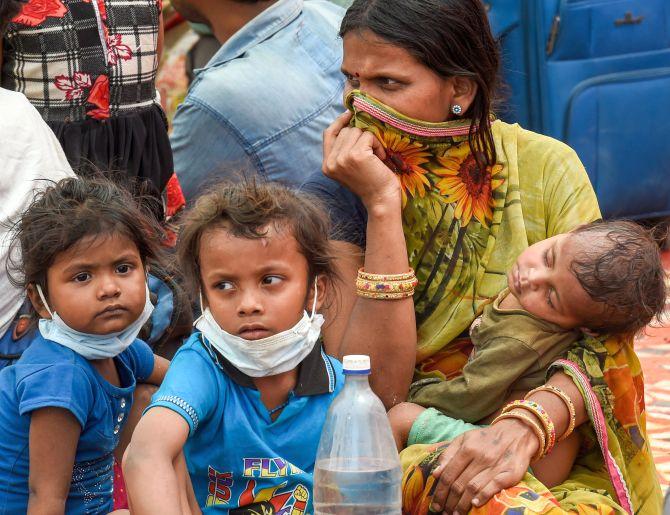 | « Back to article | Print this article |
For states like West Bengal, Bihar, Odisha, Jharkhand and Uttar Pradesh, where migration is high, the return of workers could be as much an opportunity as a liability.
All states have launched portals to register migrant workers; additional fields like nature of employment and remuneration in the past 2-3 years are being added to help in skill mapping.

After almost a month, work under MGNREGS (Mahatma Gandhi National Rural Employment Guarantee Scheme) resumed at Mohanpur, a village in North 24 Parganas, West Bengal.
Around 20 people got work, but just for a day.
Bapi Das, a migrant, who used to work for a catering service provider in Tamil Nadu, and returned home just before the lockdown to contain COVID-19, wasn’t among those lucky ones.
The demand for MGNREGS work in Mohanpur has shot up since a large number of migrants returned.
Out of work, and with little cash in hand, MGNREGS has been holding out hope.
But even as Das and his lot wait to find work, going back is the last thing on their mind.
Even with lesser pay, thousands of migrant workers who have returned are willing to battle it out in their home state.
As they juggle between risking lives and no work, states are calling out to “sons of the soil”, albeit for different reasons.
Recently, Maharashtra Chief Minister Uddhav Thackeray, appealed to the bhumiputra of Maharashtra to go and work for industries in green zones.
“Till now you stayed at home to save Maharashtra. Now, you must go to work in industries in green zones.”
Maharashtra, which has the highest share of in-migrants, is facing a labour shortage in green zones with workers from other states moving back home.
Labour shortage had forced Karnataka to cancel inter-state trains earlier.
A large number of workers from other states were engaged in the construction industry.
In a bid to woo construction workers, the Karnataka government recently provided financial support of Rs 3,000 to each of the 1.58 million registered building workers in the state as part of the state’s Rs 1,600 crore relief package.
This is over and above the Rs 2,000 that is already transferred to their accounts.
But what is a problem for Maharashtra and Karnataka, could well be a boon for West Bengal Chief Minister Mamata Banerjee.
Much before Thackeray, Banerjee reached out to migrants, asking them to stay put in their home state.
She has assured them of employment opportunities.
“A video conference with district industries centres, MSMEs and chambers, has been held,” said a senior minister in the state government.
West Bengal has about 549 industrial clusters, then there are industrial parks and karmatirthas for the micro units.
For states like West Bengal, Bihar, Odisha, Jharkhand and Uttar Pradesh, where migration is high, the return of workers could be as much an opportunity as a liability, though.
Till May 16, the Indian Railways transported about 1.5 million to their home states. But many more took the long march home.
For instance, the heavy influx of migrant labourers in Uttar Pradesh, currently estimated at 1.8 million since the COVID-19 lockdown began, has created a problem of plenty for the Yogi Adityanath government as it deals with the onerous challenge of providing local employment.
Nonetheless, Chief Minister Adityanath has instructed department heads to prepare separate roadmaps for collectively creating more than 2 million local jobs in the MSME segment, one district one product (ODOP) scheme, khadi, food processing, and so on.
In the meanwhile, the government is looking to double MGNREGA jobs to cover 5 million beneficiaries from the current 2.5 million.
UP additional chief secretary Awanish Kumar Awasthi, said the government was preparing a muster roll of all migrants, so that they could be provided with jobs. It would have details like skill set.
A major problem with migrant workers is that a large proportion is unskilled workers, and they might need skill upgradation.
That could be time consuming.
Odisha industry secretary Hemant Sharma, however, said, “When we were doing skill mapping, we found that some had ITI certificates and some even had polytechnic diplomas.
"Around 15-20 per cent of workers can be absorbed as it is, they would not require skill upgradation.”
All states have launched portals to register migrant workers; additional fields like nature of employment and remuneration in the past 2-3 years are being added to help in skill mapping.
Labour economist, K R Shyam Sundar, professor at XLRI - Xavier School of Management in Jamshedpur, said states might err in having more unskilled workers, but the skill mix will change over time.
“States must have an open door policy for migrant workers,” he added.
The Odisha government is brainstorming other plans involving migrant workers.
“May be, we could have a memorandum of understanding with a steel plant to engage migrant workers.
"This would not be mandatory, but persuasive.
"Additionally, if a big chunk of workers is from a particular sector, special incentives could be offered to attract investment in that sector,” said Sharma.
An inter-ministerial committee has been formed to reboot industry in the context of the pandemic and how to engage migrant workers could be a part of the discourse.
These are plans, however, that will take time to be implemented.
Till economic activities are restarted fully, it’s MGNREGA and government schemes that may keep the thousands who have struggled to reach home busy.
But for how long?
Pallabi Mondal, a worker with an NGO called Asha, said people don’t want to risk their lives and go back to work immediately, even if trains start running.
“The fear for life is more than the fear of job loss,” she said.
With inputs from Samreen Ahmad and Aneesh Phadnis
Photograph: Atul Yadav/PTI Photo